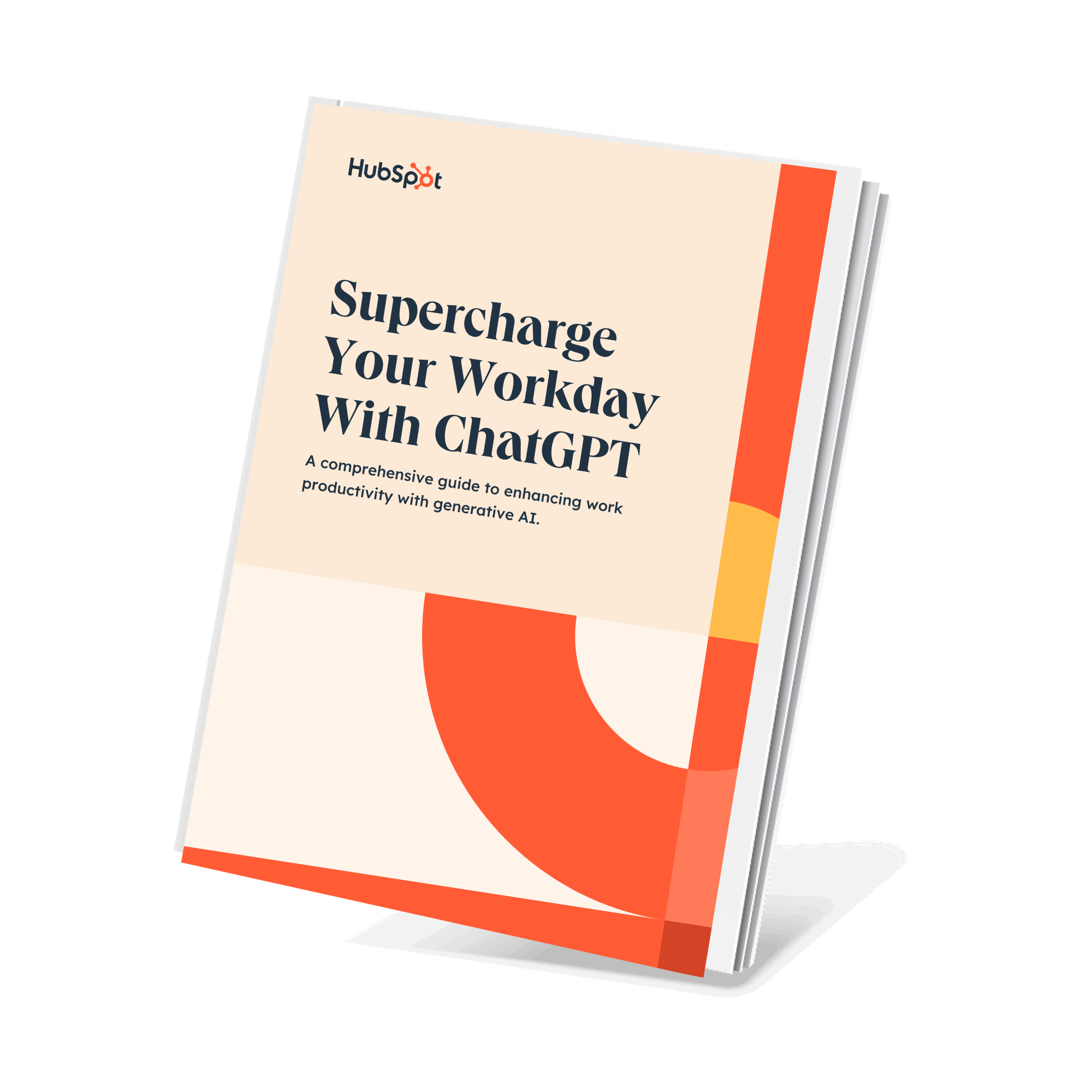Marketers are often asked to do more with less. I’ve been there too.

I’ve battled the constant pressure to juggle multiple campaigns, track their performance, and present insight-packed reports. This process is overwhelming, time-consuming, and riddled with challenges.
After years of struggling to prepare reports for my marketing campaigns, I discovered how AI reporting can truly transform the process — and empower creativity with data-backed strategies.
In this article, I’ll discuss:
Crucial Challenges Marketers Face in Traditional Reporting
Throughout my decade-long career in marketing, one of the most significant (and repeated) challenges I’ve had was reporting my work and attributing it to revenue.
I’m sure every marketer agrees that traditional reporting methods are complex and time-consuming. Reporting feels like rocket science with so many moving parts.

How to Use ChatGPT at Work
Discover the key to unlocking unparalleled productivity with this ultimate guide to revolutionizing your workflow.
- 100 ChatGPT Prompts
- Real-World Examples
- Productivity Hacks
- And More!
Download Free
All fields are required.

Here are some challenges I've faced and observed in marketing reporting.
- Tedious data collection. I’ve spent hours (and even days) consolidating, cleaning, and organizing data from different tools to build a report. I realized that a key reason marketers struggle to build a robust reporting setup is due to this inefficient and error-prone process of collecting data manually.
- Inability to measure ROI. My biggest concern with traditional reporting methods is the lack of measurable outcomes in many marketing campaigns. It’s much harder to directly attribute specific top-level metrics (like clicks, impressions, and likes) to meaningful business outcomes (like customer acquisition, retention, etc.). So, while you know how well a campaign performed, you don’t have enough proof to tie it to the results achieved.
- Siloed data. Having worked with several B2B organizations, I’ve observed that each department often works in isolation. As a result, customer data is siloed and inaccessible to every team. The sales team uses a CRM system, the marketing team relies on multiple analytics tools, and the support team works on a customer success platform. This hinders marketers’ ability to get the whole picture about their performance.
- Limited customization. Traditional reporting tools aren’t easily customizable for your reporting needs. I tried working backward with my goals to set up my reporting system, but I couldn’t fully customize my tools to track the necessary metrics. This lack of flexibility is another big reason marketers must spend extra time and effort on data-based reporting.
- Meaningful data interpretation. Lastly, after trying several reporting tools, I can say that most tools only process and visualize data. They don’t offer contextual guidance on what actions to take based on the data. I’ve spent most of my time interpreting data at scale and documenting the key takeaways to help stakeholders make data-driven decisions.
The traditional reporting setup is riddled with challenges for marketers. And it only adds to the mounting pressure marketers face to stand out in crowded markets with innovative campaigns.
The good news is there are resources like HubSpot for Marketers with tons of tools to help streamline your marketing reporting. From multi-touch revenue attribution to customer journey analytics, you can easily measure and optimize your marketing investments.
The other good news? Now, we also have AI.
That’s why I’m excited to discuss how AI reporting methods can change the game and maximize efficiency for marketers.
Let’s look at the key benefits and use cases of AI reporting.
5 Key Benefits of AI Reporting for Marketers
Our AI Insights for Marketers report indicates that nearly half (45%) of marketing leaders claim AI tools make employees more productive.
While I’ve seen marketers leverage AI for use cases like content creation and automation, I believe that’s just the tip of the iceberg. The real game-changer is the ability to use AI tools for end-to-end data analytics and performance tracking.
Here are five key areas where I think AI reporting will make life easier for marketers.
1. Streamlined Data Collection and Processing
Ask any marketer what they dislike the most about their role, and they’ll say: collecting data.
As I said before, gathering data manually is a slow and tedious process. Jumping between your social media analytics, email marketing dashboards, CRM, and other tools sometimes feels like you’re back in the Stone Age.
With AI-powered reporting, you can easily eliminate this busy work and automate data collection. These AI marketing tools will seamlessly integrate with your target channels and gather data in real time. Plus, you can configure these tools to process and analyze the data.
This AI automation for reporting can significantly reduce the manual workload and free up your time to focus on more strategic tasks.
2. Enhanced Ability to Measure ROI
One of the biggest pain points for every marketer I know is connecting their efforts directly to business outcomes.
Since traditional reporting methods focus on top-level metrics (like views, clicks, and impressions), you don’t get a clear picture of how your marketing efforts drive revenue growth.
Instead, AI reporting brings deeper insights through advanced attribution models.
AI tools can track the entire customer journey across different channels and touchpoints. So, you get clarity on how customers make buying decisions and what nudged them forward in the marketing funnel.
This benefit is also visible in our AI marketing insights report: 39% of marketers feel AI tools help make informed decisions based on performance.

3. Breaking Down Data Silos
Data silos can happen in any organization when data is stored separately for different teams and use cases. As a result, you don’t get a unified view of customer behavior or marketing performance.
AI-powered reporting can break down these silos by integrating with multiple platforms to pull real-time data and prepare a detailed report.
In fact, 44% of marketers think AI is very effective at performing data analysis, and 70% use these tools to improve their data analysis workflows.
Why? Because AI tools offer built-in dashboards to visualize cross-channel insights without any manual effort. You can automatically collate and cross-reference data from different touchpoints to provide a fuller picture of campaign performance.

4. Highly Customizable Reporting
One of the biggest benefits of AI reporting is the ability to break through the rigid reporting formats in traditional methods and build a flexible, goal-specific setup.
Instead of following irrelevant templates, AI-powered reporting allows you to customize your reports to track metrics that align with specific campaigns or strategies.
Jessica Apotheker, a marketing leader and CMO at Boston Consulting Group, explains why organizations need to build such a customized reporting setup.
In her TED talk, she emphasizes that marketers should have the right AI tools to track customer behavior, predict outcomes, and deeply analyze each campaign. This continuous feedback loop can significantly improve marketing strategies and performance.
Apotheker shares an example to showcase the results:
“A consumer goods company I worked with used these tools to gain a 'left-AI brain' advantage, building a team of 30+ experts who developed and customized these solutions. They also upskilled the entire organization.
As a result, marketers could assess which audience-creative combinations were performing well in the market, determine which products resonated with which consumers, and monitor the evolving marketing funnel. It leads to a highly adaptive and effective marketing approach.”
5. Improved Data Storytelling
Time and again, I’ve seen how traditional reporting tools struggle to translate raw data into meaningful insights. I strongly believe these reports packed with numbers and charts often fail to tell a compelling story. They don’t explain why certain metrics matter and how they impact the strategy.
That’s why I’m experimenting with AI reporting tools to interpret data, provide contextual insights, and support the decision-making process.
AI tools use natural language processing (NLP) to create a narrative around your data. They can explain trends, pinpoint gaps and opportunities, and go as far as answering specific questions you have.
Put simply, you can use AI reporting tools to understand data quickly and get actionable insights.

How to Use ChatGPT at Work
Discover the key to unlocking unparalleled productivity with this ultimate guide to revolutionizing your workflow.
- 100 ChatGPT Prompts
- Real-World Examples
- Productivity Hacks
- And More!
Download Free
All fields are required.

4 Applications of AI-Powered Reporting for Marketers
I’ve spent the last several months exploring the potential of AI reporting tools.
Besides testing out a few tools for my workflows, I also spoke to my fellow marketers to learn how they leverage AI in their reporting setup and the benefits they’ve seen so far.
I’ve curated a list of four use cases for AI in digital marketing to maximize reporting efficiency and make data-driven decisions.
Use case #1: Predictive analytics for campaign performance.
I think AI-powered predictive analytics can be a game-changer for prioritizing and executing marketing campaigns.
You can use historical data on campaign performance metrics and seasonal patterns to forecast future outcomes. You can also share more contextual details about your planned campaign with this data. Then, these AI tools will predict whether this campaign will perform well or poorly.
Besides, AI tools can simulate scenarios based on variable factors like audience segments, budgets, and more.
For instance, what happens if you allocate 20% more of your budget to social media ads in a particular demographic? AI can predict the potential outcome, allowing for better decision-making.
See AI Reporting in Action
Andy Crestidona, co-founder of Orbit Media Solutions, uses ChatGPT to analyze full-funnel campaign performance and predict future performance.
He downloads the latest reports from his email marketing platform and Google Analytics. Then, he adds this data to ChatGPT to combine the datasets and derive insights.
Here’s an example of how he instructs the tool to merge and organize the dataset.

He also uses ChatGPT to derive insights from this dataset and visualize it in different ways. For example, he asked the tool to create a chart demonstrating how different topics performed in the email marketing channel.

Use Case #2: Real-time insights for content optimization.
As a content marketer, I’ve focused heavily on using AI to build more efficient workflows.
However, I only recently discovered the power of AI tools to measure performance and optimize content for stronger results.
I use AI tools to track metrics like engagement, bounce rate, and conversion rate.
This real-time data for content posted across different channels clarifies whether a topic is a hit or a miss. This way, I can enhance underperforming content or divert resources from one campaign to another.
I also rely on HubSpot’s SEO Marketing Software to optimize content. The tool analyzes the content on any website to provide real-time recommendations for improvement.
Each recommendation flags the number of pages affected by an error and offers a clear reason why this error matters. It also tells you the impact of each recommendation so you can prioritize high-impact tasks.

Use case #3: Audience segmentation and personalization.
AI can analyze huge datasets to find patterns you’d naturally miss.
Marketers can use this capability to improve audience segmentation and deliver more targeted messaging. That’s why 34% of marketing directors say AI leads to more personal customer experiences.
For example, AI tools can analyze all available customer data and create segments based on their behavior and preferences. You can also use these tools to understand how each segment interacts with your brand.
Then, based on this audience segmentation, you can personalize the customer experience and offer tailored solutions and deals depending on each customer’s interaction history and journey.
Sarah Cornett, an AI consultant, shares how she implemented an AI solution for marketing in the banking industry to deliver a personalized customer experience and targeted communication.In a conversation about the state of AI-powered marketing, she shares a case study of her work.
“The solution used identity resolution to gather historical data about a customer, such as the products you have with us, your digital touchpoints, and real-time activity like navigating our website. By leveraging this real-time data, we could determine the most relevant communication at any given moment.
With thousands of potential topics to discuss, the AI system would analyze triggers to deliver personalized messages, whether it was a next best action, upsell, or cross-sell offer, all tailored to capture attention and provide the most contextually relevant experience.”
Use case #4: Attribution modeling and ROI tracking.
A common challenge I’ve faced is identifying the most effective marketing channels. With AI-powered attribution modeling, this becomes much easier. With AI reporting, you can pinpoint and analyze every touchpoint in a customer’s journey instead of using traditional attribution models.
With a multi-touch attribution approach, you can distribute credit to each touchpoint and present a more realistic picture of each channel’s impact. This level of granularity enables marketers to focus on the most profitable touchpoints.
Besides, you can use the multi-touch attribution data to forecast ROI for future campaigns. It’ll improve predictive analytics and streamline your marketing investments.
My Best Tips to Get Started with AI Reporting
Okay, ready to take a stab at AI reporting? Here are my best tips to help you get started.
- Automate data collection. One of the easiest ways to incorporate AI in your reporting setup is by automating data collection and processing. Integrate AI tools into your existing tech stack to combine information from multiple platforms and process data in a single dashboard.
- Audience segmentation. Use AI to analyze customer data and break down your audience into micro-segments. It will help you truly understand your customers based on behaviors, preferences, pain points, and other parameters.
- Predictive analytics. Let AI tools analyze the probability of success for every new campaign idea and prioritize ideas based on these predictions. You can also use these predictive insights to set campaign budgets and realistic outcomes to maximize the ROI.
- Data storytelling. Let AI interpret and decode complex data to derive meaningful insights. Create a narrative with your data aligned with business objectives and make it more accessible to stakeholders.
- Attribution model. When you’re ready, replace your existing attribution model with an AI-powered multi-touch model. Get a pulse of your customers at every touchpoint and track interactions on different channels with a unified reporting setup.
Remember that integrating AI into your reporting workflow should be a step-by-step process. I recommend you experiment and explore the possibilities to see where AI tools perform well for your organization.
Use AI reporting to level up your marketing strategy.
I get it: reporting is a chore. You’re tired of exporting data from half a dozen platforms and consolidating it in one place only to spend hours extracting using insights. Having felt the same frustration, I started leveraging AI tools for reporting to cut down the busy work and make this process more efficient.
My biggest takeaway from researching this article is that AI reporting is changing the way marketers approach data. It’s making data more accessible for decision-making and strategizing, so you can plan campaigns based on facts instead of just trusting your gut.

How to Use ChatGPT at Work
Discover the key to unlocking unparalleled productivity with this ultimate guide to revolutionizing your workflow.
- 100 ChatGPT Prompts
- Real-World Examples
- Productivity Hacks
- And More!
Download Free
All fields are required.

![Download Now: 100 ChatGPT Prompts for Marketers [Free Guide]](https://no-cache.hubspot.com/cta/default/53/c497a8fe-0f60-4244-9cb1-5bed4d1e5ab6.png)






![AI in Graphic Design: The Pros, Cons and What it Means for Designers [+ Expert Insight]](https://www.hubspot.com/hubfs/Untitled%20design%20-%202024-10-15T175328.927.jpg)


